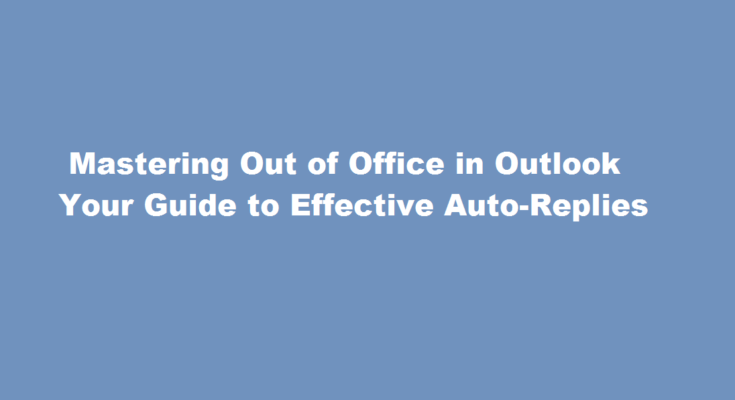Introduction
In today’s fast-paced work environment, staying connected is crucial. However, there are times when you need to take a break and step away from your email. During such occasions, Microsoft Outlook offers a valuable feature known as “Out of Office.” In this article, we will explore the ins and outs of setting up an out-of-office message in Outlook, ensuring that your absence is communicated effectively while maintaining professionalism.
Accessing the Out of Office Assistant
To activate the out-of-office auto-reply in Outlook, begin by launching the application and navigating to the “File” tab. From there, click on “Automatic Replies” to access the Out of Office Assistant. In the dialog box that appears, you’ll find options to specify the duration of your absence and compose your automated response.
Setting the Out of Office Duration
Start by selecting the “Send automatic replies” checkbox. You can then specify the date and time range for your auto-reply to activate. Outlook allows you to set different messages for internal and external senders, which can be particularly useful for managing communications with colleagues and clients separately.
Crafting an Effective Message
Your out-of-office message should strike a balance between professionalism and friendliness. Begin by expressing gratitude for the email and acknowledging the sender’s importance. Next, state the duration of your absence and provide an alternative contact person or resources for urgent matters. Remember to keep the message concise, informative, and free from jargon.
Internal and External Auto-Replies
Outlook allows you to create distinct messages for internal and external recipients. Internal auto-replies are received by colleagues within your organization, while external auto-replies are sent to clients, partners, or anyone outside your organization. Tailoring messages based on the recipient type ensures that the information provided is relevant and appropriate.
Examples of Out of Office Messages
To inspire your own out-of-office message, here are a few examples
- Internal: “Thank you for your email. I’m currently out of the office until [date]. For urgent matters, please contact [colleague’s name] at [email/phone].”
- External: “Thank you for reaching out. I’m currently away from the office until [date]. If you require immediate assistance,
Automatic Replies for Recurring Absences
If you frequently have scheduled absences, such as weekly meetings or monthly conferences, you can save time by using the “Rules” feature in Outlook. By creating a rule, you can automate the activation and deactivation of your out-of-office message for recurring events, ensuring consistent communication without the need for manual adjustments.
Testing the Out of Office Message
Before finalizing your out-of-office setup, it is crucial to test the auto-reply to ensure it is working as intended. Send a test email from an external account to verify that the message is triggered correctly, and check the formatting and grammar to maintain a professional appearance.
Deactivating Out of Office
Once you return to the office, remember to turn off the out-of-office auto-reply. Simply navigate back to the Out of Office Assistant, uncheck the “Send automatic replies” box, and save your changes. This step is essential to prevent auto-replies from being sent inadvertently when you’re back at work.
FREQUENTLY ASKED QUESTIONS
What do I write in an out of office message in Outlook?
I am currently out of the office until [return date] for [general reason]. I will be unable to reply to your message until after I return. If you need assistance in the meantime, please contact [name of colleague] at [colleague’s contact information]
What is a good automatic reply message?
Thank you for your email. I will be out of the office from mm/dd to mm/dd and will have limited access to email / will not have access to email. If this is urgent, please contact [NAME] at [EMAIL] or [PHONE]. I will do my best to respond promptly to your email when I return on mm/dd.
Conclusion
Mastering the Out of Office feature in Outlook enables you to step away from your email with confidence, knowing that your absence is clearly communicated. By following the steps outlined in this article, you can ensure that your auto-replies are informative, professional, and tailored to different recipient types. Embracing this feature will help you strike a balance between work and personal time while maintaining effective communication with your colleagues and clients.
Read Also : Unleashing Your Creativity How to Share Stories on Snapchat from Your Gallery



